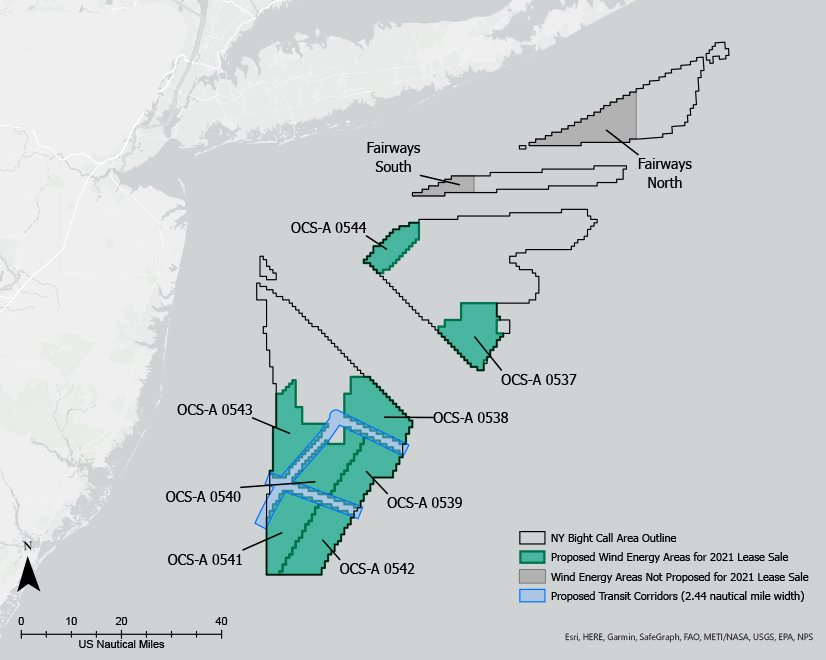The U.S. Bureau of Ocean Energy Management (BOEM) this month issued a draft environmental assessment that evaluates the potential impacts of siting new offshore wind within nearly 800,000 acres of the New York Bight.
BOEM will conduct hearings on the EA on Aug. 24 and 25 before a Sept. 9 deadline for public comment on the environmental impacts of the agency granting of rights of way (ROW) and rights of use and easement (RUE) in the region.
The American Clean Power Association on Monday issued a statement lauding BOEM for “identifying the offshore locations that are most suitable for wind energy development in the New York Bight while taking into consideration other ocean users. Commercial and recreational fishing, maritime navigation and Department of Defense activities have all been accounted for in the proposed lease areas, and potential space-use conflicts have been appropriately avoided.”
The EA covers the effects of routine and non-routine activities associated with lease and grant issuance, site characterization and site assessment, using scenarios based on BOEM’s guidance for lessees, previous lease applications and plans, and previous EAs, the agency said.
Non-routine and low-probability events and hazards that could occur include severe storms, such as hurricanes and extratropical cyclones; allisions and collisions between the site assessment structure or associated vessels and other marine vessels or marine life; spills from collisions or fuel spills resulting from generator refueling; and recovery of lost survey equipment, BOEM said.
The study did not consider the construction and operations of any commercial wind farm, which would be evaluated as part of a separate process under the National Environmental Policy Act if a lessee submits a construction and operations plan (COP).
Impact-producing factors associated with pre-construction activities include noise; air emissions; lighting; habitat degradation; vessel traffic; routine vessel discharges; bottom disturbance; and entanglement.
Comments
As part of the environmental scoping process, BOEM sought comments on the issues and alternatives to be considered in the assessment and received approximately 3,000 comments (BOEM-2021-0021).
The National Wildlife Federation, Natural Resources Defense Council and other environmental groups said they support responsible development of offshore wind energy that:
- avoids, minimizes, monitors and mitigates adverse impacts on marine and coastal wildlife and their habitats;
- reduces negative impacts on other ocean uses;
- includes robust consultation with Native American Tribes and communities;
- meaningfully engages state and local governments and stakeholders from the outset; and
- uses the best available scientific and technological data to ensure science-based and stakeholder-informed decision-making.
Anbaric Development Partners said its OceanGrid is “a reasonably foreseeable project” in the bight and that “BOEM should issue its Determination of No Competitive Interest for this nonexclusive grant both expeditiously and prior to issuing the draft EA to facilitate development of planned transmission to support the upcoming lease sales.”
Further, because ROW/RUE grants do not authorize the holder to begin any construction activity, or any other activity for which an approval is required, prior to approval of a general activities plan (GAP), the potential environmental effects related to the issuance of such a grant are limited, Anbaric said.
“Lease areas should be sized to ensure that sufficient acreage is available, after avoidance of significant marine use and natural resource constraints, to support the wind energy development required to meet state procurement goals,” commented Atlantic Shores Offshore Wind, a joint venture between Shell New Energies US and EDF Renewables North America. The partnership holds a commercial lease off New Jersey for which it recently filed a COP with BOEM.
Leaseholders also require flexibility to scale up wind energy output within a lease area, which would lower the projected cost of energy, allowing for better pricing and a more competitive auction for the lease award process, Atlantic Shores said.
The EA scoping process should continue to encourage communication, coordination and cooperation among stakeholders to lend greater certainty to the development process, as opposed to a “first come, first served” approach to development, where one leaseholder is left to accommodate all development choices of an adjacent leaseholder, Atlantic Shores said.
The Fairways North and South wind energy areas, lease areas closest to Long Island, are not being considered for leasing at this time partly because of conflicts with the proposed U.S. Coast Guard shipping safety fairway, maritime traffic concerns, commercial fisheries, state preferences, marine protected species and commercial viability, BOEM said.

